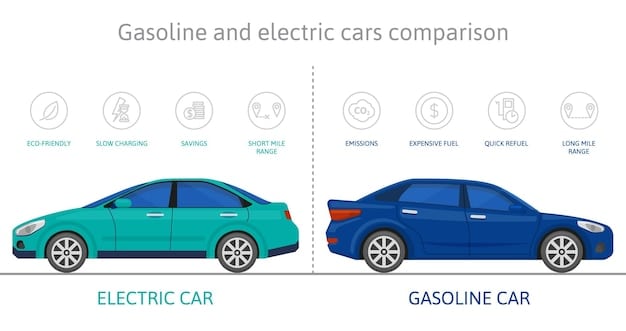Car Buying Guide 2025: Fuel Efficiency Standards Impact

Car Buying Guide 2025: Understanding the Impact of New Federal Fuel Efficiency Standards delves into how updated regulations will shape vehicle choices, affecting everything from gas mileage to the adoption of electric vehicles.
Navigating the car market in 2025 requires understanding the evolving landscape of federal fuel efficiency standards. This Car Buying Guide 2025: Understanding the Impact of New Federal Fuel Efficiency Standards provides insights into how these standards will influence your vehicle options, from traditional gasoline cars to electric alternatives.
Federal Fuel Efficiency Standards: A 2025 Overview
Federal fuel efficiency standards are undergoing significant changes, influencing the automotive industry’s direction. These standards aim to reduce greenhouse gas emissions and improve fuel economy, impacting car manufacturers and consumers alike. Understanding the context behind these regulations is crucial for making informed car-buying decisions in 2025.
The Evolution of Fuel Efficiency Standards
The history of fuel efficiency standards in the U.S. reveals a gradual tightening of regulations designed to lessen the environmental impact of vehicles. Initially, the focus was on increasing miles per gallon (MPG) for gasoline-powered cars. Now, the emphasis is shifting towards promoting electric vehicle (EV) adoption and reducing overall carbon emissions.
- Current standards mandate a certain average fuel economy across a manufacturer’s entire fleet.
- Future regulations are expected to further increase the required MPG and incentivize EV production.
- These changes require carmakers to innovate and adapt to meet stricter environmental targets.

These evolving standards directly affect the types of vehicles available on the market and their associated costs. Automakers are investing heavily in electric vehicle technology to comply with regulations and appeal to environmentally conscious consumers. The long-term goal is to foster a sustainable transportation system that minimizes air pollution and reduces reliance on fossil fuels.
How Fuel Efficiency Standards Affect Car Manufacturers
Fuel efficiency standards place significant pressure on car manufacturers, forcing them to invest in new technologies and redesign their production processes. The cost of compliance can be substantial, but companies that embrace innovation are more likely to thrive in the changing market.
One key aspect is the need to balance the production of fuel-efficient vehicles with larger, less efficient models. Manufacturers often rely on selling a mix of cars and trucks to meet overall fleet targets. However, increasing demand for SUVs and trucks poses a challenge to meeting stricter standards.
Strategies for Compliance
Manufacturers employ various strategies to comply with fuel efficiency standards. These include:
- Developing and selling more electric and hybrid vehicles.
- Improving the fuel economy of gasoline-powered cars through advanced engine technology.
- Reducing vehicle weight using lighter materials.
- Optimizing aerodynamics to minimize drag.
Failure to meet fuel efficiency standards can result in hefty fines and penalties, incentivizing manufacturers to prioritize compliance. Some companies have formed partnerships to share technology and reduce the financial burden of developing new fuel-efficient vehicles.
The Impact on Car Prices and Availability
New federal fuel efficiency standards can influence both car prices and the availability of certain models. As manufacturers invest in new technologies to comply with regulations, these costs may be passed on to consumers in the form of higher vehicle prices.
Additionally, some manufacturers may choose to discontinue less fuel-efficient models in favor of those that meet the standards. This can lead to a narrower range of options for buyers who prefer larger vehicles or those with specific performance characteristics.
Potential Cost Increases
The integration of advanced technologies such as electric powertrains and lightweight materials can significantly increase the cost of producing a vehicle. While some of these costs may be offset by government incentives and tax credits, consumers should be prepared for potentially higher prices on new cars.
However, the long-term cost of ownership may be lower for fuel-efficient vehicles due to reduced fuel consumption and maintenance expenses. Electric vehicles, in particular, can offer significant savings on fuel costs, as electricity is typically cheaper than gasoline. Government incentives, such as tax credits and rebates, can further reduce the upfront cost of buying an EV.
Understanding MPG and Electric Vehicle Equivalents
Miles per gallon (MPG) has long been the standard metric for measuring fuel efficiency. However, with the rise of electric vehicles, a new metric called “MPGe” (miles per gallon equivalent) has emerged to compare the energy efficiency of EVs with gasoline cars. Understanding these metrics is essential for making informed buying decisions.
MPG measures how many miles a car can travel on one gallon of gasoline. Higher MPG values indicate better fuel efficiency. MPGe, on the other hand, measures how many miles an EV can travel on the energy equivalent of one gallon of gasoline. This allows consumers to compare the energy efficiency of EVs and gasoline cars on a level playing field.
Comparing MPG and MPGe
When comparing MPG and MPGe, consider the following:
- MPG is relevant for gasoline-powered cars, while MPGe is used for electric vehicles.
- Higher MPG and MPGe values indicate better energy efficiency.
- MPGe takes into account the energy content of electricity compared to gasoline.

While MPGe provides a useful comparison, it’s important to consider other factors such as the cost of electricity versus gasoline, driving range, and charging infrastructure when evaluating electric vehicles. Government websites and consumer reports provide detailed information on MPG and MPGe ratings for various models.
The Future of Electric Vehicles and Charging Infrastructure
Electric vehicles are becoming increasingly popular due to their environmental benefits and lower operating costs. However, the widespread adoption of EVs depends on the development of a robust charging infrastructure. Car Buying Guide 2025 can’t ignore this issue.
Governments and private companies are investing heavily in building out charging networks across the country. This includes installing more charging stations at public locations, workplaces, and residential areas. As the charging infrastructure expands, range anxiety – the fear of running out of battery power – will become less of a concern for EV drivers.
Advancements in Charging Technology
In addition to expanding the number of charging stations, advancements in charging technology are making it faster and more convenient to charge electric vehicles. Fast charging stations can now add significant range to an EV in a relatively short amount of time. Wireless charging technology is also emerging, allowing drivers to charge their cars simply by parking over a charging pad.
The future of electric vehicles also includes advancements in battery technology. New battery designs are increasing energy density, allowing for longer driving ranges and faster charging times. Solid-state batteries, in particular, hold promise for significantly improving the performance and safety of electric vehicles. The new federal fuel efficiency standards anticipate and encourage the shift to EV.
Making Informed Car-Buying Decisions in 2025
As you navigate the car market in 2025, it’s essential to consider the impact of new federal fuel efficiency standards on your vehicle options. Start by assessing your driving needs and priorities. Determine whether fuel economy, performance, or environmental impact is most important to you.
Research different models and compare their MPG or MPGe ratings. Factor in the potential cost savings of fuel-efficient vehicles, as well as any government incentives or tax credits that may be available. Consider the long-term cost of ownership, including fuel or electricity expenses, maintenance costs, and insurance rates. It will be key in having the best car buying guide 2025 could offer.
Tips for Choosing the Right Vehicle
As the car market changes, here are some tips for a car buying guide 2025:
- Read reviews from trusted sources.
- Take test drives to assess handling and performance.
- Evaluate safety features and crash test ratings.
- Research reliability ratings.
By carefully considering these factors, you can make an informed decision and choose a vehicle that meets your needs and budget while also aligning with your environmental values. Fuel efficiency standards directly affect what is available.
| Key Aspect | Brief Description |
|---|---|
| 🚗 Fuel Efficiency Standards | Regulations aimed to improve fuel economy and reduce emissions. |
| ⚡ Electric Vehicle (EV) | Vehicles powered by electricity, offering zero tailpipe emissions. |
| 💰 Cost of Ownership | Total expenses of owning a car, including fuel, maintenance, and insurance. |
| ⛽ MPG and MPGe | Metrics for measuring fuel efficiency in gasoline cars (MPG) and electric vehicles (MPGe). |
Frequently Asked Questions
▼
Federal fuel efficiency standards are regulations set by the government to improve the average fuel economy of vehicles sold in the United States. They aim to reduce greenhouse gas emissions and promote energy conservation.
▼
Compliance with fuel efficiency standards can lead to higher car prices due to the investment in advanced technologies. However, long-term savings on fuel and potential incentives can offset initial costs.
▼
MPGe (miles per gallon equivalent) measures the energy efficiency of electric vehicles, while MPG (miles per gallon) is used for gasoline cars. MPGe allows for a comparison of energy efficiency between EVs and gasoline cars.
▼
While the initial cost of EVs might be higher, they often have lower operating costs due to cheaper electricity and reduced maintenance. Government incentives can also lower the upfront price.
▼
The charging infrastructure is rapidly expanding with increasing investments from governments and private companies. This includes more charging stations and advancements in charging technology to improve convenience.
Conclusion
Understanding the impact of new federal fuel efficiency standards is crucial for making informed car-buying decisions in 2025. As the automotive industry shifts towards more fuel-efficient and electric vehicles, consumers can benefit from lower operating costs and reduced environmental impact. Staying informed about these changes will help you choose the right vehicle for your needs and budget.





